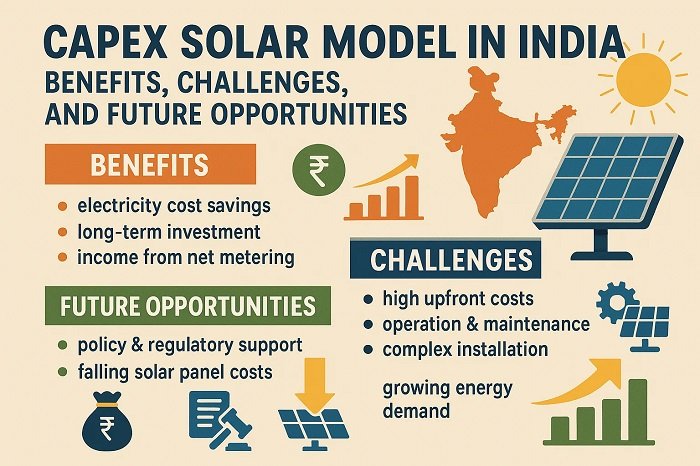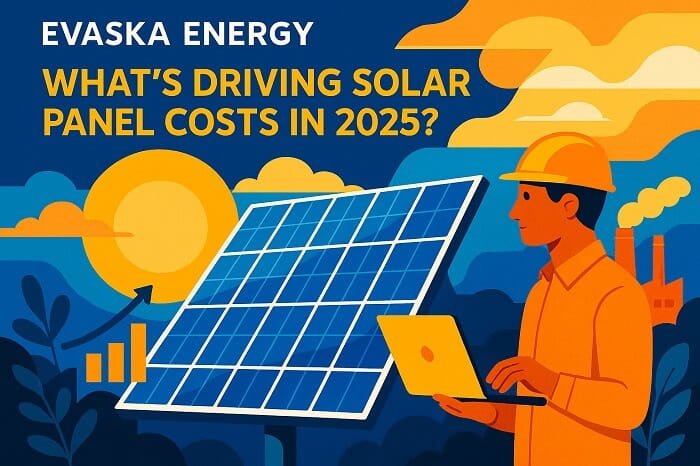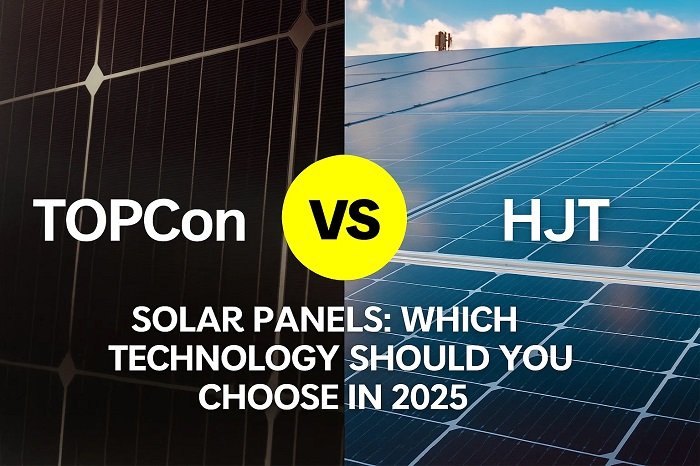capex solar model india benefits challenges opportunities
India is one of the fastest-growing solar energy markets in the world. With increasing awareness of renewable energy and government initiatives, both businesses and individuals are actively exploring solar solutions. Among the different financing models available for adopting solar power, the CAPEX solar model is one of the most widely used in India. It allows consumers to own their solar systems, enjoy long-term savings, and contribute to a greener future.
What is the CAPEX Solar Model?
CAPEX stands for Capital Expenditure. Under the CAPEX solar model, the consumer invests upfront to purchase and install the solar system. The ownership of the system remains with the buyer, whether it is a business, an industrial unit, or a residential customer.
Once installed, the consumer enjoys free electricity from solar power for the system’s lifetime, typically 25 years, after accounting for minimal operation and maintenance costs. In simple words, the CAPEX model means you own the asset and reap the direct benefits of your investment.
This model is quite popular among large industries, commercial establishments, and institutions in India because it reduces long-term energy costs and improves sustainability credentials.
Benefits of the CAPEX Solar Model
- Ownership and Control: The biggest advantage of the CAPEX model is ownership. Once you invest in the system, you have complete control over its operation and maintenance. Unlike other models such as RESCO (Renewable Energy Service Company), where the asset is owned by a third party, CAPEX ensures you are the sole beneficiary of all savings.
- Maximum Savings in the Long Run: Although the initial cost may seem high, the CAPEX solar model delivers significant savings over the lifetime of the system. After recovering the investment through reduced electricity bills (payback period is usually 3–5 years), the electricity generated for the remaining 20+ years is practically free.
- Government Incentives and Subsidies: The Indian government, through agencies like MNRE (Ministry of New and Renewable Energy), offers attractive subsidies for residential rooftop solar projects under the CAPEX model. Commercial and industrial consumers also benefit from accelerated depreciation, GST benefits, and net-metering policies, further improving the return on investment.
- Energy Independence: With rising grid tariffs and concerns about power reliability, CAPEX solar provides a hedge against future price increases. By generating your own clean electricity, you reduce dependency on the grid and ensure predictable energy costs.
- Sustainability and Brand Image: For businesses, adopting the CAPEX solar model is not just about savings—it also demonstrates commitment to sustainability. Customers, investors, and regulators increasingly prefer companies that prioritize renewable energy. Installing solar under CAPEX enhances a brand’s green image and aligns with India’s push toward net-zero targets.
Challenges of the CAPEX Solar Model
While the CAPEX model is attractive, it also comes with certain challenges that consumers must consider before investing.
- High Upfront Investment: The most significant barrier is the initial capital requirement. Installing a solar system requires a large one-time investment, which may not be feasible for small businesses or households without financial support.
- Maintenance Responsibility: Since the ownership remains with the consumer, they are responsible for maintaining the system. Although annual maintenance contracts (AMCs) can reduce the burden, it still requires regular monitoring and timely servicing.
- Long Payback Period for Small Consumers:For households with lower electricity consumption, the payback period may be longer compared to industrial or commercial consumers. This sometimes discourages residential adoption.
- Space Availability: Installing a solar system requires adequate shadow-free rooftop or ground space. Many urban homes or businesses face limitations in this regard, making CAPEX adoption challenging.
- Technology Upgrades: With solar technology evolving rapidly, some consumers worry that their system may become outdated over time. However, this risk is common to most capital investments in technology.
Future Opportunities for CAPEX Solar Model in India
Despite these challenges, the CAPEX solar model is expected to remain a strong driver of India’s solar growth. The government aims to achieve 500 GW of renewable energy capacity by 2030, and rooftop solar is a crucial part of this mission.
- Falling Solar Prices: The cost of solar panels and equipment has been decreasing steadily, making CAPEX solar more affordable. As prices continue to decline, more consumers will find the upfront investment feasible.
- Supportive Policies: With state-level net-metering regulations, central subsidies, and schemes like PM Surya Ghar Muft Bijli Yojana, the policy framework in India strongly supports rooftop solar adoption. This will accelerate CAPEX installations across residential, commercial, and industrial segments.
- Green Financing Options: Banks and financial institutions are increasingly offering loans for rooftop solar projects at attractive interest rates. Such financing options reduce the burden of upfront capital and make CAPEX more accessible.
- Corporate Sustainability Goals: As more companies commit to using renewable energy under global frameworks like RE100, the CAPEX solar model will play a key role in meeting their green energy targets. This is particularly relevant for manufacturing and IT companies with high energy demands.
- Job Creation and Local Manufacturing: The expansion of CAPEX solar will not only benefit consumers but also create employment opportunities in installation, maintenance, and manufacturing. With the government promoting “Make in India” for solar components, domestic production will further boost the model’s attractiveness.
The CAPEX solar model has established itself as one of the most reliable and cost-effective methods for adopting solar energy in India. While it requires significant upfront investment and maintenance responsibility, the long-term financial savings, government incentives, and sustainability benefits make it a highly rewarding choice.
As technology advances, costs fall, and financing options improve, CAPEX solar is poised to become the preferred model for businesses and households committed to reducing their energy costs and carbon footprint. For Indian customers looking at long-term energy independence and environmental responsibility, the CAPEX model offers a bright and sustainable future.







